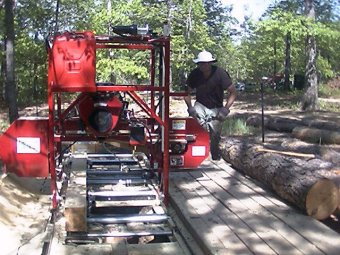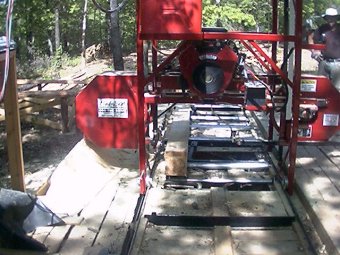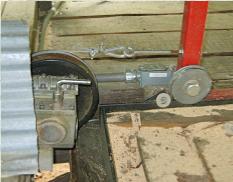Cable Drive And A Sore
Pushbutton Finger
There is nothing more rewarding than milling your own lumber from trees that come from your own place. At the end of the day seeing that stack of lumber is truly instant gratification regardless of the fatigue factor from bucking logs, hauling boards and pushing the saw through timber. Of course though I do believe that pushing the band blade is ultimately more tiring than bucking logs and stacking boards. Thus this salvaged mind came up with an idea.
Over the years I have accumulated many interesting little gadgets and electrical parts from the many salvage yards and retrofits to machines I have done in the past. Finally, there comes a time to either put this stuff to use or haul it off. It did amaze me as to the amount of re-workable parts I did have.
After sitting down and attempting to remember the art form of drawing up electrical schematics. Yes, an excellent schematic is truly an art form, something I can never achieve. With many pencil erasures and the paper thin, I finally had what appeared to be a working electrical plan for operation. I did begin though with a written thought process of what I wanted Oscar to do on his own with a human at the controls. Most importantly though it had to be simple and no computer behind the workings.
What I wanted Oscar to perform was rather simple, cut through the log under some type of speed control. Once the cut was completed the carriage must travel up a set distance to clear the log or cant, and then travel back to whence he started. This of course all sounds easy enough, at least on paper.
We had the height set taken care of through the DRO. But how to set that height was another ideal altogether. No to mention the distance for different log lengths. And of course keeping it all under budget, which means -- next to nothing. The answer for us came in the form of an old refrigeration control board I had purchased at a salvage yard many years ago. I believe I had paid around $.07 a pound for this 150 pound control board. This gem of a find had everything I needed, limit switches in the form of an old cam type timer and the sweetest parts of all, sixteen Square D relays that had interchangeable contacts from N.O. to N.C.. All of which had to be cleaned up but once finished, checked out good as new.
I know the boring stuff right? But I am a Pack Rat at heart and to tell the truth, besides making lumber from logs, I do enjoy the challenge of a problem to be solved.
Parts and more parts came into play as the system came into reality. I was able to use the old relays for a simple control of relay logic that was actuated from properly placed limit switches and the action of pushbuttons and auto switching. In other words when you press the button something happens and hopefully what you want to happen.
The system has a master switch for manual or automatic. The distance and height control was achieved through some simple limit dogs that are clamped to the track rail and height indicator on Oscar. The motor/cable drive is controlled by a simple 24-VDC speed controller and powered by two 12v deep cycle batteries. They are recharged whenever the entire system is powered down for the day. The motor is a heavy duty right angled gearbox assembly which produces more than enough torque to do the job.
All of this movement is transferred to the carriage by a simple cable that pulls the carriage in either direction. The cable allows a slip factor in case we run into trouble with cutting a log i.e. dull blade or foreign object in log.
In the end once all tested and the bugs worked our cut rate had jumped by more than 75%. But most importantly was the finish dress on the board cuts. They were amazing, no tooth marks.
But best of all, is that at the end of an afternoon of cutting lumber, the only soreness for the stick pusher (Kat), is a sore finger from pressing the start cycle button.
Next Article: Log beams and roller tables and saving me from an aching back.




